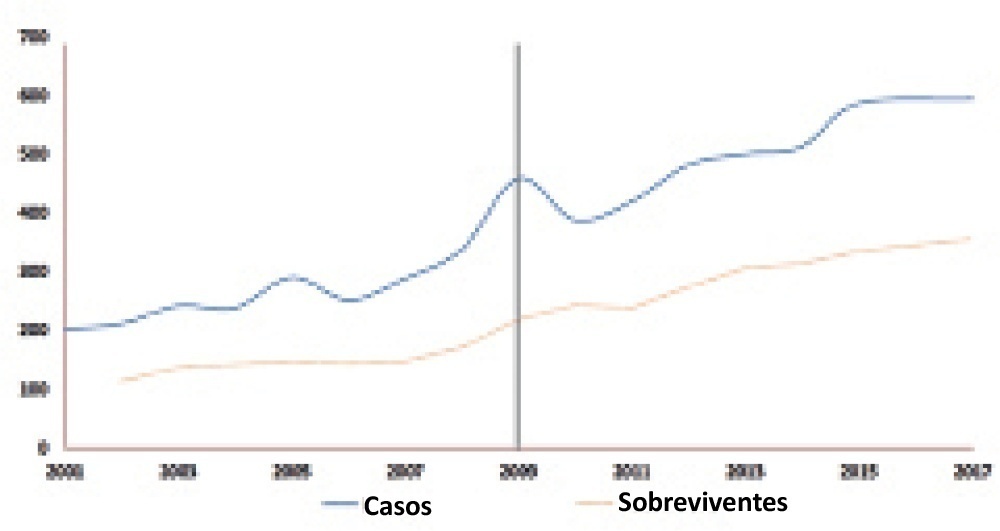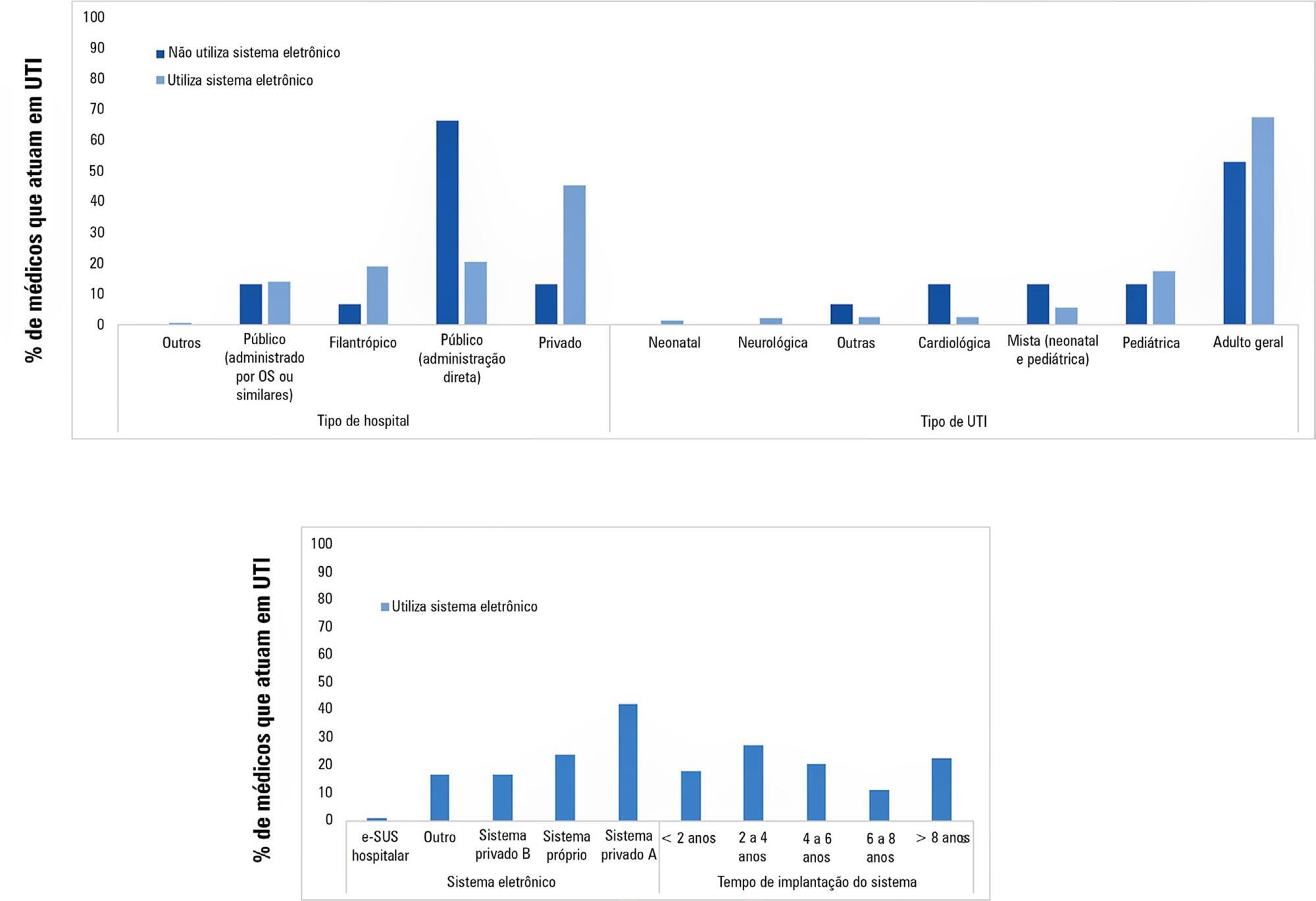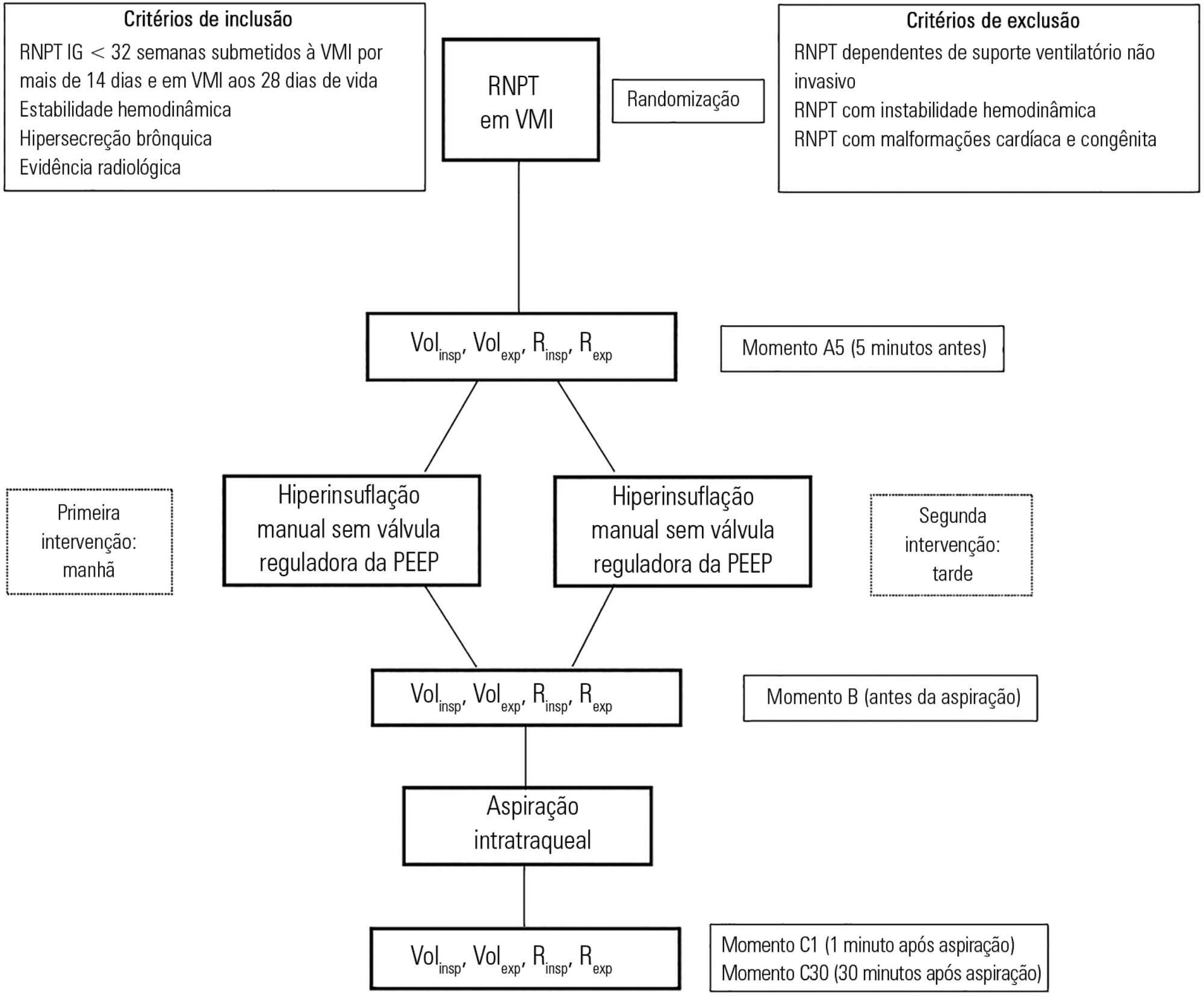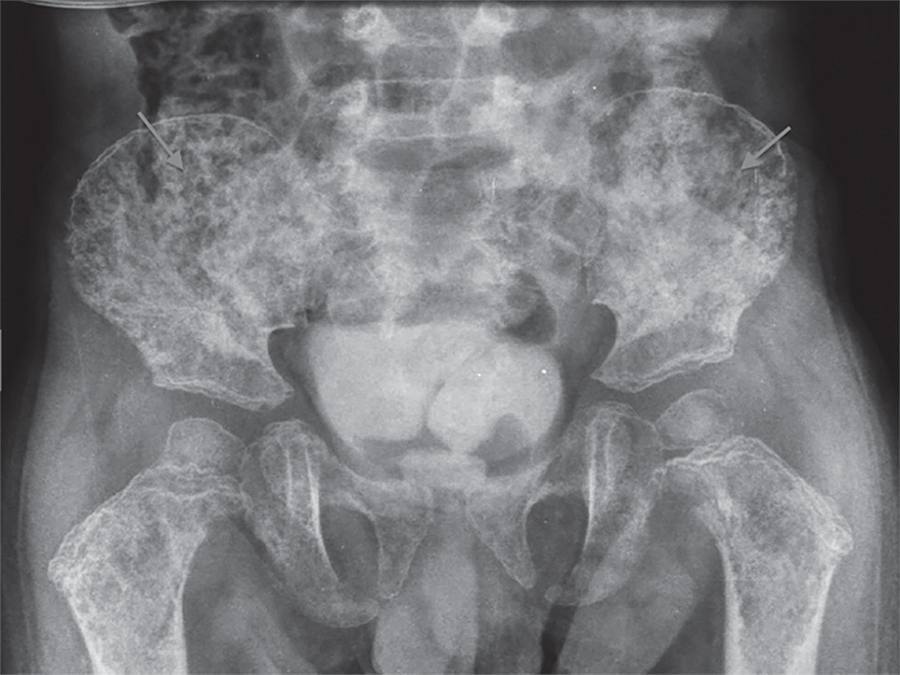You searched for:"Werther Brunow de Carvalho"
We found (17) results for your search.-
Original Article
Extracorporeal membrane oxygenation for respiratory failure in children: the years before and after the 2009 H1N1 pandemic
Rev Bras Ter Intensiva. 2021;33(4):544-548
Abstract
Original ArticleExtracorporeal membrane oxygenation for respiratory failure in children: the years before and after the 2009 H1N1 pandemic
Rev Bras Ter Intensiva. 2021;33(4):544-548
DOI 10.5935/0103-507X.20210082
Views0ABSTRACT
Objective:
To evaluate whether there was any impact on the number of pediatric extracorporeal membrane oxygenation runs and survival rates in the years subsequent to the 2009 pandemic.
Methods:
We studied two different periods of extracorporeal membrane oxygenation support for respiratory failure in children by analyzing datasets from the Extracorporeal Life Support Organization. Autoregressive integrated moving average models were constructed to estimate the effect of the pandemic. The year 2009 was the year of intervention (the H1N1 epidemic) in an interrupted time series model. Data collected from 2001 – 2010 were considered preintervention, and data collected from 2010 – 2017 were considered postintervention.
Results:
There was an increase in survival rates in the period 2010 – 2017 compared to 2001 – 2010 (p < 0.0001), with a significant improvement in survival when extracorporeal membrane oxygenation was performed for acute respiratory failure due to viral pneumonia. The autoregressive integrated moving average model shows an increase of 23 extracorporeal membrane oxygenation runs per year, prior to the point of the level effect (2009). In terms of survival, the preslope shows that there was no significant increase in survival rates before 2009 (p = 0.41), but the level effect was nearly significant after two years (p = 0.05), with a 6% increase in survival. In four years, there was an 8% (p = 0.03) increase in survival, and six years after 2009, there was up to a 10% (p = 0.026) increase in survival.
Conclusion:
In the years following 2009, there was a significant, global incremental increase in the extracorporeal membrane oxygenation survival rates for all runs, mainly due to improvements in the technology and treatment protocols for acute respiratory failure related to viral pneumonia and other respiratory conditions.
Keywords:ARDSChildExtracorporeal membrane oxygenationH1N1H1N1 SubtypeHumanInfluenzaInfluenza A virusPandemicsRespiratory distress syndromeRespiratory insufficiencySurvival rateSee more
-
Commentary
Pediatric ventilation weaning
Rev Bras Ter Intensiva. 2020;32(3):333-336
Abstract
CommentaryPediatric ventilation weaning
Rev Bras Ter Intensiva. 2020;32(3):333-336
DOI 10.5935/0103-507X.20200061
Views0IMPORTANCE OF MECHANICAL VENTILATION RELEASEMechanical ventilation (MV) is a widely used practice among pediatric intensive care units (PICUs) throughout the world. Data from multicenter studies reveal rates of use ranging from 20% to 64%, and MV typically lasts approximately 5 to 6 days.(,) The practice of using artificial methods to provide respiratory care is considered […]See more -
Original Article
Does vancomycin administered at an empirical dose ensure coverage of pediatric patients against gram-positive pathogens?
Rev Bras Ter Intensiva. 2020;32(3):391-397
Abstract
Original ArticleDoes vancomycin administered at an empirical dose ensure coverage of pediatric patients against gram-positive pathogens?
Rev Bras Ter Intensiva. 2020;32(3):391-397
DOI 10.5935/0103-507X.20200067
Views0Abstract
Objective:
To investigate the vancomycin effectiveness against gram-positive pathogens with the minimum inhibitory concentration of 1mg/L in pediatric patients based on the area under the curve and the minimum inhibitory concentration ratio > 400.
Methods:
A population of 22 pediatric patients (13 boys) admitted to the pediatric intensive care unit with preserved renal function was stratified in two groups (G1 < 7 years and G2 ≥ 7 years). After the fourth dose administered of vancomycin (10 - 15mg/kg every 6 hours) was administered, two blood samples were collected (third and fifth hours), followed by serum measurement by immunoassays to investigate the pharmacokinetics and antimicrobial coverage.
Results:
There was no difference between the groups regarding dose, trough level or area under the curve. Coverage against gram-positive pathogens with a minimum inhibitory concentration of 1mg/L occurred in only 46% of patients in both groups. The pharmacokinetics in both groups were altered relative to the reference values, and the groups differed in regard to increased total body clearance and shortening of the biological half-life, which were more pronounced in younger patients.
Conclusion:
A minimum empirical dose of 60mg/kg per day should be prescribed for pediatric patients in intensive care units with preserved renal function. The use of the ratio between the area under the curve and minimum inhibitory concentration in the evaluation of vancomycin coverage is recommended to achieve the desired outcome, since the pharmacokinetics are altered in these patients, which may impact the effectiveness of the antimicrobial.
Keywords:ChildDrug monitoringPediatric intensive care unitsPharmacokineticsPharmacologic actionsVancomycin/administration & dosageSee more
-
Original Articles
Respiratory distress syndrome: influence of management on the hemodynamic status of ≤ 32-week preterm infants in the first 24 hours of life
Rev Bras Ter Intensiva. 2019;31(3):312-317
Abstract
Original ArticlesRespiratory distress syndrome: influence of management on the hemodynamic status of ≤ 32-week preterm infants in the first 24 hours of life
Rev Bras Ter Intensiva. 2019;31(3):312-317
DOI 10.5935/0103-507X.20190056
Views0ABSTRACT
Objective:
To investigate the influence of respiratory distress syndrome management on clinical and echocardiographic parameters used for hemodynamic evaluation in ≤ 32- week newborns.
Methods:
Thirty-three ≤ 32-week newborns were prospectively evaluated and subjected to invasive mechanical ventilation. The need for exogenous surfactant and clinical and echocardiographic parameters in the first 24 hours of life was detailed in this group of patients.
Results:
The mean airway pressure was significantly higher in newborn infants who required inotropes [10.8 (8.8 – 23) cmH2O versus 9 (6.2 – 12) cmH2O; p = 0.04]. A negative correlation was found between the mean airway pressure and velocity-time integral of the pulmonary artery (r = -0.39; p = 0.026), right ventricular output (r = -0.43; p = 0.017) and measurements of the tricuspid annular plane excursion (r = -0.37; p = 0.036). A negative correlation was found between the number of doses of exogenous surfactant and the right ventricular output (r = -0.39; p = 0.028) and pulmonary artery velocity-time integral (r = -0.35; p = 0.043).
Conclusion:
In ≤ 32-week newborns under invasive mechanical ventilation, increases in the mean airway pressure and number of surfactant doses are correlated with the worsening of early cardiac function. Therefore, more aggressive management of respiratory distress syndrome may contribute to the hemodynamic instability of these patients.
Keywords:EchocardiographyHemodynamicsInfant, prematurePulmonary surfactantsRespiratory distress syndrome, newbornSee more -
Original Article
Evaluation of the use of electronic medical record systems in Brazilian intensive care units
Rev Bras Ter Intensiva. 2018;30(3):338-346
Abstract
Original ArticleEvaluation of the use of electronic medical record systems in Brazilian intensive care units
Rev Bras Ter Intensiva. 2018;30(3):338-346
DOI 10.5935/0103-507X.20180057
Views0ABSTRACT
Objective:
To examine the prevalence of the use of electronic medical record systems in Brazilian intensive care units and the perceptions of intensive care physicians regarding the contribution of electronic medical record systems toward improving safety and quality in clinical practice.
Methods:
Using an online questionnaire, physicians working in Brazilian intensive care units answered questions about the use of electronic medical record systems in the hospitals in which they worked. They were asked about the types of electronic medical record systems used and their levels of satisfaction with these systems in terms of improving quality and safety.
Results:
Of the 4,772 invitations sent, 204 physicians responded to the questionnaire. Most used electronic medical record and prescription systems (92.6%), worked in private hospitals (43.1%), worked in general adult intensive care units (66.7%) and used Private System A (39.2%); most systems had been used for between 2 and 4 years (25.5%). Furthermore, the majority (84.6%) believed that the electronic system provided better quality than a paper system, and 76.7% believed that electronic systems provided greater safety than paper systems.
Conclusion:
Electronic medical record systems seem to be widely used by the Brazilian intensive care physicians who responded to the questionnaire and, according to the data, seem to provide greater quality and safety than do paper records.
Keywords:BrazilElectronic health recordsHealth information systemHealth information technologyHealth surveysIntensive care unitsMedical informaticsSee more
-
Original Articles
Effects of manual hyperinflation in preterm newborns under mechanical ventilation
Rev Bras Ter Intensiva. 2016;28(3):341-347
Abstract
Original ArticlesEffects of manual hyperinflation in preterm newborns under mechanical ventilation
Rev Bras Ter Intensiva. 2016;28(3):341-347
DOI 10.5935/0103-507X.20160058
Views0ABSTRACT
Objective:
To assess the effects of manual hyperinflation, performed with a manual resuscitator with and without the positive end-expiratory pressure valve, on the respiratory function of preterm newborns under mechanical ventilation.
Methods:
Cross-sectional study of hemodynamically stable preterm newborns with gestational age of less than 32 weeks, under mechanical ventilation and dependent on it at 28 days of life. Manual hyperinflation was applied randomly, alternating the use or not of the positive end-expiratory pressure valve, followed by tracheal aspiration for ending the maneuver. For nominal data, the two-tailed Wilcoxon test was applied at the 5% significance level and 80% power.
Results:
Twenty-eight preterm newborns, with an average birth weight of 1,005.71 ± 372.16g, an average gestational age of 28.90 ± 1.79 weeks, an average corrected age of 33.26 ± 1.78 weeks, and an average mechanical ventilation time of 29.5 (15 – 53) days, were studied. Increases in inspiratory and expiratory volumes occurred between time-points A5 (before the maneuver) and C1 (immediately after tracheal aspiration) in both the maneuver with the valve (p = 0.001 and p = 0.009) and without the valve (p = 0.026 and p = 0.001), respectively. There was also an increase in expiratory resistance between time-points A5 and C1 (p = 0.044).
Conclusion:
Lung volumes increased when performing the maneuver with and without the valve, with a significant difference in the first minute after aspiration. There was a significant difference in expiratory resistance between the time-points A5 (before the maneuver) and C1 (immediately after tracheal aspiration) in the first minute after aspiration within each maneuver.
Keywords:Infant, newbornIntensive care, neonatalPositive pressure respirationRespiration, artificialRespiratory therapySee more
-
Letters to the Editor
To: Contemporary treatment of children with critical and near-fatal asthma
Rev Bras Ter Intensiva. 2016;28(3):356-357
Abstract
Letters to the EditorTo: Contemporary treatment of children with critical and near-fatal asthma
Rev Bras Ter Intensiva. 2016;28(3):356-357
DOI 10.5935/0103-507X.20160063
Views1To the Editor The review article by Shein et al.() on the treatment of acute severe asthma in children is timely due to the prevalence of the disease and often variable and inconsistent disease management, which includes adjuvant therapies and depends on the availability of resources, the local practices and the preference of doctors. The […]See more -
Letters to the Editor
To: Severe hypercalcemia as a form of acute lymphoblastic leukemia presentation in children
Rev Bras Ter Intensiva. 2016;28(2):199-200
Abstract
Letters to the EditorTo: Severe hypercalcemia as a form of acute lymphoblastic leukemia presentation in children
Rev Bras Ter Intensiva. 2016;28(2):199-200
DOI 10.5935/0103-507X.20160034
Views1To the Editor, Severe hypercalcemia of malignancy in children has been extensively described in the medical literature.() However, this complication usually presents as a late symptom of acute lymphoblastic disease and not as an early manifestation, as described in a case report by Martins et al.() Colleti Junior et al.() also observed that hypercalcemia was […]See more
Search
Search in:
KEY WORDS
Case reports Child Coronavirus infections COVID-19 Critical care Critical illness Extracorporeal membrane oxygenation Infant, newborn Intensive care Intensive care units Intensive care units, pediatric mechanical ventilation Mortality Physical therapy modalities Prognosis Respiration, artificial Respiratory insufficiency risk factors SARS-CoV-2 Sepsis




